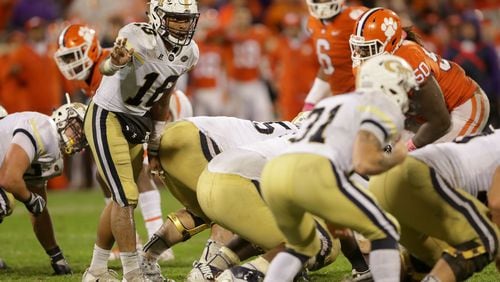Georgia Tech’s spring-practice scrimmages and practices are closed to the public and media, so what can be learned about the Yellow Jackets largely is up to what coach Paul Johnson and his players choose to disclose.
On Monday, Johnson shared a particularly juicy statistic from the team’s Saturday morning scrimmage: Quarterback TaQuon Marshall completed 10 of 13 passes.
“The stats were better, but it’s still a work in progress,” Johnson said.
For Tech fans who hope for more out of the passing game next season, perhaps the key word in Johnson’s assessment was “progress.” Last season, Marshall’s first as the starter, he completed 37.1 percent of his passes. Marshall’s predecessor, Justin Thomas, had season completion averages of 51.3 percent, 41.7 percent and 53.4 percent.
At the start of spring practice, Marshall said that he had flaws in his passing delivery that he wanted to correct, notably dropbacks that were too short and a tendency to overstride when he stepped into his throws. Marshall said Monday, after the ninth of 15 spring-practice sessions, that he had definitely progressed.
“Because I know the first scrimmage, I left some balls out there that probably weren’t thrown too well – well, they weren’t thrown too well,” he said. “Missed a lot of wide-open guys. So that was one of the things that I really wanted to focus on going into the next scrimmage, just trying to hit the wide-open guys and just make some crisp reads and crisp passes.”
Georgia Tech's TaQuon Marshall expecting 'a big difference'
Marshall said, too, that he was taking the prescribed dropbacks, which has helped provide him a better field of vision.
“We’re not going to change his throwing motion; he’s a senior in college,” Johnson said. “But it’s more the mechanical stuff. I’m talking about, like, if it’s a three-step drop, take a three-step drop. If it calls for five, take five. If it’s a sprintout, get your shoulders square, get yourself in position. Because he’s got the ability to throw the ball if he gives himself a chance. But you’ve got to get fundamentals down to get set.”
Marshall’s 10 completions were a mix of short passes and downfield shots. Four of the completions went for 15 yards or longer, although one was a screen pass, according to a loose tally kept by Tech’s communications office. Wide receiver Jalen Camp caught a 20-yard touchdown pass down the left sideline and won a 40-yard jump ball.
“It’s reps,” Johnson said. “We talk about experience; he played for a year, right? We forget that he’s not like JT (Justin Thomas), who was a three-year starter. So I think the more reps he gets every day, I’m sure he can tell you he learned something every day. That’s the nature of the game.”
It portends well for an offense that will bring back 10 starters, including Marshall, who started at least six games last season. Tech’s offense is run-based, but thrives when it can pick up chunks of yardage off play-action passes. For instance, the Yellow Jackets produced 12 pass plays of 40 yards or more in 2016, sixth in the ACC. They did so despite attempting only 160 passes, whereas the rest of the league averaged 437 attempts.
“His accuracy is definitely better,” offensive tackle Jahaziel Lee said. “He’s doing a better job throwing that long ball.”
As the nearly 12-point spread of Thomas’ season completion percentages would suggest, Marshall’s completion rate last season wasn’t solely his doing. Pass protection failed him at times, forcing Marshall to throw under heavy pressure or take sacks. Tech’s ratio of pass attempts per sack (6.0) easily was the worst of Johnson’s tenure. Lee said that the line has been practicing this spring with tighter splits – the gaps between offensive linemen as they take their stance at the line of scrimmage – in passing situations.
“As splits get smaller, then it’s harder for linebackers to see that, ‘OK, this is an open area; let me run through it,’” Lee said. “Or when D-linemen are slanting, the holes are closing up, so it’s harder for them to get through. That definitely helps.”
Marshall said he doesn’t pay attention to the width of the splits, but added that he has had plenty of time to throw. He said he has also been mindful of staying in the pocket to throw and not bailing out to scramble.
“So I guess whatever they’re doing is working,” he said.
And with that, Tech fans are now free to start worrying about the state of the pass rush.







